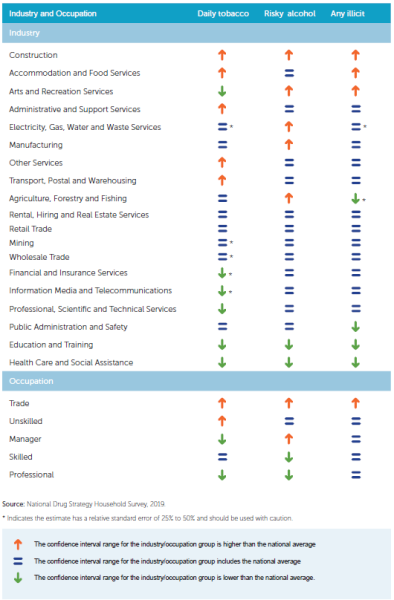Alcohol and other drug use among employed Australians, opportunities for intervention
Background
As most Australians who use alcohol, tobacco and other illicit drugs (ATOD) are employed, workplaces represent potentially effective sites for harm minimisation initiatives that benefit the entire community. To determine where best to target workplace intervention efforts, as well as key considerations when designing workplace interventions, The National Centre for Education, Training and Addiction (NCETA) developed two reports.
The first report investigated patterns, prevalence and profiles of ATOD use among Australian workers using the National Drug Strategy Household Survey (NDSHS) and the Household, Income and Labour Dynamics in Australia (HILDA) datasets (1).
The key findings of the first report were (refer to full report for CIs and statistical tests):
- In 2019, 58% of Australians aged 14+ years were employed.
- Three industries employed over one-third of Australian workers (health care and social assistance: 19%, education and training: 10%, professional, scientific and technical services: 9%).
- Compared to the general population, a higher proportion of employed Australians drank alcohol at risky levels (38% v 32%). Consistent with drinking in the general population, these rates were higher amongst men (46% male v 28% female) and those living in higher socio-economic areas (39% high v 36% low).
- The prevalence of daily smoking among employed Australians was 11%, comparable to that of the Australian population.
- Illicit drug use prevalence was higher among employed Australians (19%) than among the total Australian population (16%).
- Alcohol and other drug-related absenteeism remains a major cost to the Australian economy with alcohol-related absenteeism costing $3.9 billion and Illicit drug-related absenteeism costing $2.9 billion per annum.
The following table highlights industry and occupation groups whose ATOD prevalence was above, below or equivalent to the employed national average for 2019. As shown in this table, the construction industry and trade occupation groups have higher ATOD use across all substances and should be prioritised for interventions to reduce ATOD use and associated harms.
Table 1: Industry and occupation groups whose daily smoking, risky alcohol or any illicit consumption in the past 12 months prevalence was above, below or equivalent to the employed national average, 2019#

*Employed national average of daily smoking was 11%; risky alcohol consumption 38%; and illicit drug use in past 12 months 19%
# please refer to full report for further detail
Our second report (2) investigated the presence of AOD policies in workplaces using NDSHS data, and reviewed evidence on workplace interventions.
The key findings of the second report were:
- Approximately 60% of employed Australians were aware that their workplace had an alcohol and/or drug policy. One in ten people were unaware whether their workplace had an AOD policy in place.
- Reviews on AOD workplace policies found that the presence of policies could deter use of alcohol during working hours but that policies were more effective when supplemented with a larger suite of interventions. Workplace policies should ensure their information focusses on risks to health and safety, are developed in consultation with AOD experts, legal and HR expertise and employee representatives, are clearly communicated and regularly reviewed.
- Only one in six workers reported having access to AOD education or information and one in five reported having access to assistance programs for staff members with AOD concerns indicating a lack of awareness of existing programs, and a lack of programs.
- Workers who were more likely to drink at risky levels and use drugs had high levels of psychological distress, indicating that workplace programs should also focus on broader worker wellbeing.
- One in five workers reported the presence of an AOD testing policy in their workplace. However, these policies were much more common in safety-sensitive industries (e.g., mining approx. 80%; electricity, gas, water and waste services approx. 70%; and transport, postal and warehousing approx. 55%).
- A systematic review indicated that drug testing as a sole strategy is not sufficient to address AOD use and harms in the workplace. Evidence quality was poor and findings mixed on the effectiveness of workplace drug testing for deterring use or reducing accidents and injury.
- Evidence from an umbrella review of reviews supported multi-component interventions (e.g., policy plus education, screening and brief interventions) that addressed all AOD use, considered the broader fitness for work framework rather than detection only, were embedded in well-being programs, and were tailored to specific workplace cultures and contexts.
- Emerging issues for workplaces include e-cigarettes, medicinal cannabis use, new psychoactive substances and performance enhancing drugs.
Overall, these findings highlight that not all AOD impacts relate to heavy machinery or workplace safety risks. AOD-related absenteeism remains a significant cost to the Australian economy. With only one in six workers reporting having access to AOD education and information, there is much room for improvement and opportunities for early intervention. Workplace strategies need to be developed and tailored to suit specific workplaces and industries, with national statistics indicating that workers in construction and trades would benefit most.
What’s next?
NCETA are now working with a number of workplaces and industries to pilot interventions and take these findings forward. We welcome collaborations in this space. For more information please contact Kirrilly Thompson or Jacquie Bowden.
Research team: Alice McEntee, Vinita Duraisingam, Roger Nicholas, Sophie Pointer, Aubyn Pincombe and Jacqueline Bowden
Funding: This research was funded by the Commonwealth Department of Health and Aged Care.
- McEntee, A., Pointer, S., Pincombe, A., Nicholas, R. and Bowden, J. (2023). Alcohol and other drug use: A focus on employed Australians: Part 1: Prevalence and consequences. Adelaide, South Australia: National Centre for Education and Training on Addiction (NCETA), Flinders Health and Medical Research Institute (FHMRI), Flinders University. ISBN: 978-1-876897-71-0. Available online at https://nceta.flinders.edu.au/application/files/5016/8723/8146/DOH-Workplace-Report-Part1.pdf
- Duraisingam, V. McEntee, A., Nicholas, R., Pointer, S. and Bowden, J. (2023). Alcohol and other drug use: A focus on employed Australians: Part 2: Implications for Workplaces. Adelaide, South Australia: National Centre for Education and Training on Addiction (NCETA), Flinders Health and Medical Research Institute (FHMRI), Flinders University. ISBN: 978-1-876897-71-0. Available at https://nceta.flinders.edu.au/application/files/9916/8723/8263/DOH-Workplace-Report-Part2.pdf











